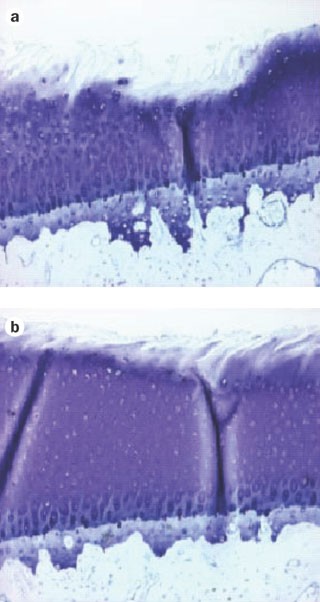
Targeting cathepsin k to prevent cartilage loss: evidence from a dog model of oa
- Select a language for the TTS:
- UK English Female
- UK English Male
- US English Female
- US English Male
- Australian Female
- Australian Male
- Language selected: (auto detect) - EN
Play all audios:

Access through your institution Buy or subscribe Connor, J. R. _ et al_. Protective effects of a cathepsin K inhibitor, SB-553484, in the canine partial medial meniscectomy model of
osteoarthritis. _Osteoarthritis Cartilage_ doi:10.1016/j.joca.2009.03.015 New research suggests that blocking the activity of cathepsin K could prevent the structural damage associated with
osteoarthritis (OA), a condition for which no disease-modifying therapies are currently available. The mild-to-moderate beneficial effects of treatment observed in the canine partial medial
meniscectomy model of the disease suggest that “inhibition of cathepsin K may represent a valid therapeutic strategy for treatment of OA,” say the study's lead investigators, Janice
Connor and Sanjay Kumar. This is a preview of subscription content, access via your institution ACCESS OPTIONS Access through your institution Subscribe to this journal Receive 12 print
issues and online access $209.00 per year only $17.42 per issue Learn more Buy this article * Purchase on SpringerLink * Instant access to full article PDF Buy now Prices may be subject to
local taxes which are calculated during checkout ADDITIONAL ACCESS OPTIONS: * Log in * Learn about institutional subscriptions * Read our FAQs * Contact customer support Authors * Sarah
Price View author publications You can also search for this author inPubMed Google Scholar RIGHTS AND PERMISSIONS Reprints and permissions ABOUT THIS ARTICLE CITE THIS ARTICLE Price, S.
Targeting cathepsin K to prevent cartilage loss: evidence from a dog model of OA. _Nat Rev Rheumatol_ 5, 411 (2009). https://doi.org/10.1038/nrrheum.2009.113 Download citation * Issue Date:
August 2009 * DOI: https://doi.org/10.1038/nrrheum.2009.113 SHARE THIS ARTICLE Anyone you share the following link with will be able to read this content: Get shareable link Sorry, a
shareable link is not currently available for this article. Copy to clipboard Provided by the Springer Nature SharedIt content-sharing initiative
